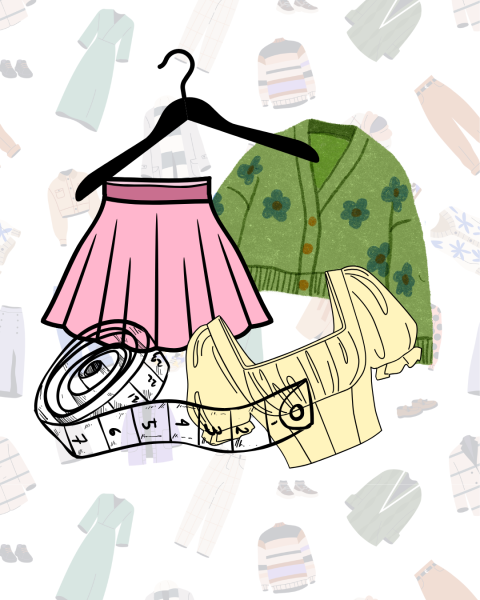
I love to shop, especially online shopping. However, my biggest pet peeve is shopping online and realizing that the measurements are not all that true to size…..
There are many online representations of this struggle shown in a term called “vanity sizing,” more typically known in stores where they will only have in stock on a saleroom floor sizes between 0-4. These sizes contain the ideal image of a consumer, not how the range of consumers actually purchase size-wise.
In a time where personal identity is often linked to appearance and self-expression, the fashion industry’s embrace of “vanity sizing” poses serious downsides for young consumers. As clothing sizes continue to shrink their clothing and still be sized normally, the impact of these altered measurements takes over shopping habits, self-esteem and body image.
Vanity sizing, a marketing strategy that allows brands to label their garments with smaller sizes than actual measurements, empowers companies to create an appealing illusion. Especially for young girls and even extending to students on our GCSU campus, the perception of wearing a
“size small” can be intoxicating, lending a sense of status in social interactions and on social media platforms.
However, this superficial allure often masks a larger concern: the disconnect between size labels and reality, which can lead to confusion and frustration among consumers.
The shift from in-store to online shopping has further emphasized the issues surrounding vanity sizing. As more young consumers turn to online platforms emphasizing convenience and variety, they are often met with inconsistent sizing charts and confusing fit descriptions.
“The size and shape of my body has remained more or less the same for years – it’s the ability to know whether or not a purchase will fit that has fluctuated,” said Leah Harper, editor for The Guardian. “Ask any woman, and they’ll tell you that finding the perfect T-shirt in, say, a size 10 from one brand doesn’t mean you’ll fit size 10 T-shirts everywhere. You may not even fit other size 10 t-shirts from the same shop.”
With inconsistent sizing and the challenge of finding a shirt that actually “fits,” the rise of influencer culture and social media amplifies these concerns.
Young adults are bombarded with images of seemingly perfect bodies and curated lifestyles, all often enhanced through filters and edited photographs. As they compare themselves to these idealized representations, the pressure to fit into smaller sizes intensifies.
“Sizing has definitely changed over the years,” said Kaylee Colwell, a sophomore special education major. “Maybe not significantly, but I have noticed that what was once considered a 6 is now a 4 or even a 2, and while I think part of it is coming from a place of “body positivity” and good intentions, it’s mostly just an annoying thing that has made it more challenging to shop by making sizing inconsistent.”
In this environment, vanity sizing seems to offer a fleeting sense of validation. Yet, it ultimately reinforces unhealthy standards that can contribute to anxiety and body dysmorphia.
“The rise of so-called vanity sizing has rendered most labels meaningless,” said Eliana Dockterman for Time Magazine. “As Americans have grown physically larger, brands have shifted their metrics to make shoppers feel skinnier—so much so that a women’s size 12 in 1958 is now a size 6…67% of American women wear a size 14 or above, and most stores don’t carry those numbers, however arbitrary they may be.”
Retailers, sensically aware of the psychological impact of vanity sizing, must reconsider their approach to product labeling. Some brands have started to adopt more inclusive sizing strategies, aiming to provide a better reflection of the diverse body types that exist in reality.
Fashion retailers should prioritize transparency in their sizing practices, giving detailed measurements that empower consumers to make informed choices.
As the conversation surrounding body positivity and acceptance grows, the industry stands at a crossroads. Young consumers deserve clarity over illusion and the freedom to embrace their authentic selves without the pressures of a misleading size label.
It is time for fashion to move beyond vanity sizing and create an inclusive environment that celebrates all shapes and sizes. Clothing should be about freedom of expression, not stuck in the confines of what is the “right” or “correct” size because there isn’t an answer!
The need for honesty in clothing sizes has never been clearer. Vanity sizing may attract shoppers, but it creates barriers that inhibit self-acceptance and complicate the shopping experience.
If the fashion industry hopes to foster a healthy relationship with its younger audience, it must break free from the superficial chains of vanity sizing once and for all.
All of us, no matter our age or gender, should feel like we don’t “fit.” If the sizing stays inconsistent, we don’t have to feel inconsistent too.
The clothes are meant to fit YOU!

